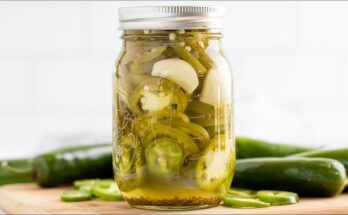Canned Salmon Recipe: Let’s be honest—canned salmon doesn’t get the credit it deserves. People often walk right past it in the grocery aisle, favoring fresh fillets or frozen options. But here’s the thing: canned salmon is an underrated powerhouse. It’s fast, affordable, and packed with flavor and nutrients. Whether you’re a busy student, a working parent, or just someone who wants to whip up a satisfying meal in minutes, this humble pantry staple can be your best friend.
Think of it like that friend who never brags but always comes through when you need them. You don’t have to worry about defrosting or splurging at the fish counter. It’s always there, ready to jump into a quick salad, a hearty patty, or a zesty sandwich filling.
And the best part? There’s no fancy culinary degree required. You just need a few basic ingredients and some kitchen love to turn canned salmon into a dish that’ll impress even the pickiest eater.
Benefits of Using Canned Salmon
So why choose canned salmon over other options? First off, the nutrition. Canned salmon is rich in omega-3 fatty acids, vitamin D, and protein—a trifecta that supports heart health, brain function, and muscle repair. It’s particularly great for those who want the benefits of fish but don’t have access to fresh seafood.
Then there’s the price point. Compared to fresh salmon, the canned version is a fraction of the cost. That makes it ideal for meal planning on a budget without compromising on health.
Another major perk? Shelf life. While fresh fish lasts only a couple of days, canned salmon can sit in your pantry for months (even years) without losing its quality. That means it’s always ready when you are.
Plus, it’s incredibly versatile. From patties to pasta, and from breakfast to dinner, canned salmon fits into countless recipes. You can go classic or creative—the choice is yours.
Types of Canned Salmon
Before we jump into the actual recipe, let’s talk about your options when it comes to buying canned salmon. There’s more variety than you might think, and picking the right type can seriously impact your final dish.
- Pink Salmon: The most budget-friendly. It’s lighter in flavor and a bit softer in texture. Great for patties and salads.
- Red (Sockeye) Salmon: Richer, bolder taste with a vibrant color. Ideal if you want a stronger salmon flavor in your dish.
- Skin & Bones: These versions are packed with calcium and nutrients. Don’t worry—they’re soft and edible, but you can remove them if you prefer a smoother texture.
- Boneless & Skinless: Super convenient. Just open the can and go.
- Wild-Caught vs Farmed: Wild-caught tends to have a cleaner, more natural taste and is often higher in omega-3s.
Pick based on your taste preferences and recipe goals. Any type works for this guide, so you can’t really go wrong.
List of Ingredients You’ll Need
Here’s what you’ll want to gather for a classic canned salmon recipe—think salmon patties or cakes. These ingredients are pantry-friendly and can be easily swapped based on your dietary needs.
Main Ingredients
- 2 cans (14.75 oz) of canned salmon, drained
- 2 large eggs
- 1/2 cup breadcrumbs (or crushed crackers)
- 1/4 cup finely chopped onion
- 1 tablespoon Dijon mustard
- 2 tablespoons fresh parsley (or 1 tbsp dried)
- Salt and black pepper to taste
- 1 tablespoon lemon juice
- 1/2 teaspoon garlic powder
- 1/4 teaspoon paprika (optional)
Optional Add-ins for Extra Flavor
- Chopped green onions
- Dill
- Grated parmesan
- Hot sauce or chili flakes for heat
- A dollop of mayonnaise or Greek yogurt for extra moisture
These ingredients give you a base, but feel free to adjust. Vegetarian? Skip the eggs and use a flaxseed or chia substitute. Gluten-free? Use almond flour or gluten-free breadcrumbs. You’re the boss of your kitchen!
Kitchen Tools and Utensils
Don’t worry—you won’t need any fancy gadgets. Just a few basic tools will get the job done smoothly.
- Mixing bowl
- Fork (for flaking the salmon)
- Knife and cutting board (for chopping herbs and onions)
- Measuring cups and spoons
- Frying pan or skillet
- Spatula
- Plate with paper towels (for draining patties)
If you’re baking or air-frying, you’ll also want:
- Baking tray with parchment paper or non-stick spray
- Air fryer basket
Having these on hand makes prep and cleanup a breeze.
Step-by-Step Guide to the Perfect Canned Salmon Recipe
Let’s get to the heart of it—the how-to. Here’s a foolproof, step-by-step breakdown to make perfect canned salmon patties or cakes.
Step 1: Open and Drain the Canned Salmon
Start by carefully opening the cans of salmon. Pour off any excess liquid, but don’t squeeze it dry—you want a bit of moisture to keep the mixture tender.
Step 2: Remove Skin and Bones (Optional)
If your salmon comes with skin and bones, now’s the time to pick them out. They’re completely edible and soft (and full of calcium), but if texture bothers you, just use a fork or fingers to remove them. Some people blend it in for extra nutrition without even noticing.
Step 3: Flake and Mix
Use a fork to gently flake the salmon in a large mixing bowl. You’re aiming for small chunks—not a paste. This gives your patties some texture and bite.
Step 4: Add Seasonings and Binders
Now add your eggs, breadcrumbs, onion, herbs, lemon juice, mustard, and seasoning. Mix everything until it just comes together. You’re not kneading bread here—overmixing will make the patties dense.
Step 5: Form into Patties or Balls
Using clean hands, scoop about 1/4 to 1/3 cup of the mixture and shape into a patty. You should get around 6-8 patties, depending on size. You can also roll them into balls if you’re making salmon bites or sliders.
Step 6: Cook (Pan-Fry, Bake, or Air Fry)
Time to cook! You’ve got options:
- Pan-Fry: Heat oil in a skillet over medium heat. Cook patties 3–4 minutes per side until golden brown and crispy.
- Bake: Preheat oven to 400°F (200°C). Bake patties on a lined tray for 15–18 minutes, flipping halfway.
- Air Fry: Spray patties lightly with oil and air fry at 375°F (190°C) for 10–12 minutes, flipping halfway.
Step 7: Serve and Enjoy
Serve your salmon patties hot with a squeeze of lemon, your favorite dipping sauce, or over a fresh salad. Leftovers? Store in the fridge or freezer for quick meals later.
Pro Tips for the Best Results
Let’s face it, even a simple canned salmon recipe can go south if you miss a few key tricks. Want your salmon patties to be crispy on the outside, tender inside, and bursting with flavor? Then these pro tips are for you.
- Don’t Overmix: Think of your salmon mixture like cookie dough—gentle handling makes for a better texture. Stir until just combined.
- Chill Before Cooking: If your mixture feels too soft or sticky, place it in the fridge for 15–30 minutes. This helps the patties hold their shape when cooking.
- Use Oil Wisely: For frying, use a neutral oil with a high smoke point, like canola or avocado oil. Don’t drown the patties—just a light coating in the pan is perfect.
- Crack the Crispiness Code: Want ultra-crispy patties? Lightly coat them in panko before frying or baking. Game changer!
- Taste-Test First: Cook a mini test patty before making the full batch. That way, you can adjust seasoning to taste before it’s too late.
If your patties are falling apart, you may need more binder (like egg or breadcrumbs). Too dry? Add a bit of mayo or even a splash of olive oil to bring in more moisture.
Creative Variations of the Recipe
Once you’ve mastered the basic canned salmon recipe, it’s time to level up. These fun and flavorful variations will keep your taste buds on their toes.
Spicy Salmon Cakes
Love heat? Add:
- 1 finely chopped jalapeño
- 1 tsp hot sauce or sriracha
- 1/2 tsp cayenne pepper
Top with a spicy mayo or serve with a cooling cucumber yogurt dip.
Salmon Patties with an Asian Twist
For a totally different vibe, mix in:
- 1 tbsp soy sauce
- 1 tsp grated ginger
- 1/2 tsp sesame oil
- Finely chopped green onions
Serve with a soy dipping sauce and sprinkle of sesame seeds.
Keto-Friendly Salmon Patties
Cut the carbs without losing flavor:
- Replace breadcrumbs with almond flour or crushed pork rinds
- Skip sugary sauces
- Serve with avocado and a side of greens
This version is perfect for low-carb or paleo diets.
What to Serve with Canned Salmon Recipes
So you’ve got your golden, crispy salmon patties ready. Now what? Time to build out the plate! Here are some winning sides and sauces that pair beautifully.
Dipping Sauces
- Classic Tartar Sauce
- Garlic Aioli
- Spicy Sriracha Mayo
- Honey Mustard
- Dill Yogurt Sauce
Side Dishes
- Roasted Vegetables: Think carrots, zucchini, or asparagus.
- Salads: A fresh green salad with lemon vinaigrette adds balance.
- Rice or Quinoa: For a heartier meal.
- Sweet Potato Fries: Crispy and sweet—perfect combo.
- Coleslaw: Crunchy, tangy, and refreshing.
Feel free to mix and match depending on the occasion—whether it’s a quick lunch or a fancy dinner.
Storage and Reheating Tips
One of the best things about canned salmon recipes? They’re great for meal prep. You can make a batch and store leftovers for later without losing quality.
Storing in the Fridge
- Keep in an airtight container.
- Lasts for 3–4 days.
- Place parchment between patties to avoid sticking.
Freezing Instructions
- Freeze uncooked or cooked patties.
- Wrap individually in plastic wrap and store in a freezer bag.
- Will last up to 3 months.
Reheating Tips
- Stovetop: Reheat over low heat in a non-stick pan.
- Oven: Bake at 350°F (175°C) for 10 minutes.
- Air Fryer: Crisp them up at 375°F (190°C) for 5–6 minutes.
Avoid the microwave if possible—it tends to dry them out and make them rubbery.
Health Benefits of Canned Salmon
Let’s talk nutrition. Canned salmon is more than just convenient—it’s a nutritional powerhouse that deserves a spot in your weekly meal rotation.
- Omega-3 Fatty Acids: These heart-healthy fats reduce inflammation, boost brain function, and support skin health.
- High Protein: With around 20–25 grams per serving, it’s excellent for muscle growth and satiety.
- Vitamin D: A crucial nutrient that many people lack, especially in colder months.
- Calcium (if using bone-in): Supports bone strength and overall health.
It’s also naturally low in carbs and sugar, making it ideal for many diets—including keto, paleo, and Whole30.
Bonus? No need to worry about mercury levels as much as with other types of fish. Salmon, especially wild-caught, tends to be lower in mercury compared to tuna or swordfish.
Common Mistakes to Avoid
We all make mistakes in the kitchen, but here are some common salmon slip-ups and how to avoid them.
Mistake #1: Overmixing the Mixture
Doing this can make the patties dense and chewy. Mix gently and only until everything is combined.
Mistake #2: Not Draining Properly
Too much liquid makes the mixture soggy. Drain the salmon well, but keep just enough moisture for tenderness.
Mistake #3: Skipping the Test Patty
Always cook a small patty first to test seasoning. Better safe than sorry!
Mistake #4: Using the Wrong Binder Ratio
Too much egg or breadcrumb can ruin the texture. Stick to the balance we mentioned in the recipe, and adjust as needed.
Gluten-Free and Dairy-Free Modifications
Want to make this recipe fit your dietary needs? No problem. Here’s how to keep it gluten-free, dairy-free, and still delicious.
For Gluten-Free
- Replace regular breadcrumbs with gluten-free breadcrumbs, oats, or crushed rice crackers.
- Use gluten-free soy sauce or tamari if making an Asian twist.
For Dairy-Free
- Skip any cheese add-ins.
- Use dairy-free mayo or yogurt for added creaminess.
You won’t miss a thing—these swaps are subtle and won’t affect the flavor much.
Kid-Friendly Canned Salmon Recipes
Got picky eaters in the house? No worries. With a few simple tweaks, canned salmon can become a kid-approved favorite.
- Shape Matters: Turn the patties into fun shapes using cookie cutters.
- Mild Flavors: Skip the spicy seasonings and stick to garlic powder, a bit of lemon, and maybe a touch of ketchup.
- Serve with Dips: Kids love dipping! Offer ranch, ketchup, or honey mustard.
- Mini Sliders: Turn patties into mini burgers served in slider buns.
Canned salmon is a great way to sneak in those omega-3s and high-quality protein into your kid’s diet—without the dinnertime drama.
FAQs about Canned Salmon Recipe
1. Can I use canned tuna instead of salmon in this recipe?
Yes, but the flavor and texture will be different. Tuna is drier and less rich than salmon, so you might need to add a bit more moisture like mayo or olive oil.
2. Do I have to remove the bones and skin from canned salmon?
Nope! They’re completely edible and soft. But if texture bothers you, go ahead and take them out.
3. Can I freeze the uncooked salmon patties?
Absolutely. Form them, wrap individually, and freeze. Thaw before cooking, or cook from frozen with a bit more time.
4. What’s the best sauce to serve with salmon cakes?
Tartar sauce, garlic aioli, or a spicy mayo are all excellent choices.
5. Is canned salmon safe to eat right out of the can?
Yes! It’s fully cooked during the canning process. You can eat it straight or mix it into recipes without further cooking.
Conclusion
Canned salmon is the quiet hero of the pantry. It’s affordable, nutritious, and wildly versatile. Whether you’re whipping up a quick weeknight dinner, prepping lunch for the week, or trying to eat healthier without spending hours in the kitchen, this recipe has got your back.
From crispy salmon cakes to creative global-inspired twists, there’s a version for everyone. Plus, the ingredients are easy to swap based on your dietary needs or what you’ve got on hand.
So next time you spot those humble cans of salmon on the shelf, don’t walk past them. Pick one up, and transform it into something crave-worthy.



